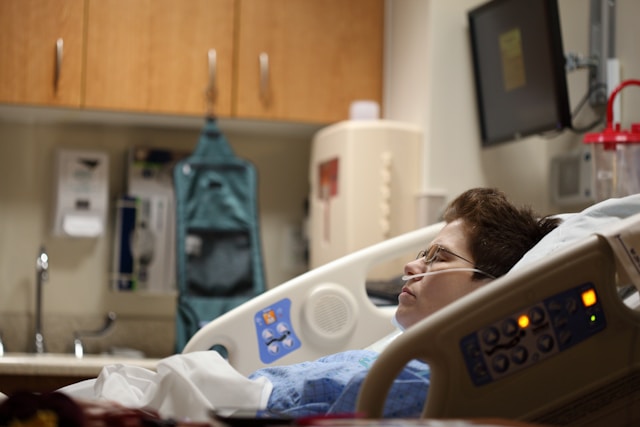The United States' healthcare system is currently in a state of concern. The country is facing problems with the workforce shortage, an aging population, and a growing mental health crisis, which have all been exacerbated by the COVID-19 pandemic.
Data has revealed that the US healthcare industry is experiencing a severe shortage of workers at every level. This shortage includes doctors, nurses, techs, and aides; it’s a multi-faceted issue that is expected to only get worse over the next decade.
Several factors contribute to the healthcare staff shortage, including emotional burnout, rising demand, low pay, and a lack of interest from prospective students. Statistics have shown that fewer students are enrolling in healthcare-related programs in the US, like the accelerated nursing programs in Texas.
According to a new survey published by Gallup and Emory University’s Rollins School of Public Health, healthcare access and affordability are Americans’ top public health concerns, followed by ensuring safe food and water and reducing chronic disease.
The Rollins-Gallup health survey
Following the Trump administration’s plans to implement changes to national public health, the Gallup and Emory University’s Rollins School of Public Health surveyed to better understand public opinion on trending health topics.
This survey asked 2,121 adults in the United States, aged 18 and older, their opinion on the following public health topics.
-
If the United States has made progress in addressing key health concerns over the past decade
-
What sources of health information do they trust the most (and least)
-
Whether federal or state government could most effectively address their concerns
The survey also asked the participants to rank public health issues they thought should be given the highest priority by the government leaders at this time. The data and findings have been published as part of a report, ‘Public Health Priorities and the Pathway Forward’.
The key findings
The Rollins-Gallup report includes the answers from the survey, including further information on public health issues by partisanship. The report is eye-opening, showing the role politics plays in public health, as well as how age and education level can be a factor.
The key findings from the report include:
-
One in four respondents selected healthcare access as their highest-rated priority. More than half of the survey respondents had it in their top three priorities.
-
Other top priorities alongside healthcare access included ensuring safe food and water, reducing chronic disease, and strengthening safety net programs.
-
A majority of the survey’s respondents felt that the federal government could address their top public health concerns better than state governments could.
-
The least trusted sources of public health information were political leaders.
-
Trust varied greatly across demographic groups. For example, respondents aged 18 to 29 years old trust scientific research and healthcare providers equally, while adults 65 and up were much more likely to trust just their healthcare provider.
A few of the lower-ranked public health priorities included:
-
Ensuring access to comprehensive reproductive healthcare
-
Preparing for emerging infectious diseases and possible future pandemics
-
Ensuring childhood vaccination against preventable diseases
-
Improving health in rural communities
-
Reducing loneliness/social isolation
Politics and public health
The report also highlighted how politics factored into the survey results. The report found that Republicans leaned toward food and water safety as a priority, while Democrats had primarily chosen healthcare access and affordability as their highest.
The results also found a difference in the trust in public health information between the political groups. Social media as a source of public health information was trusted more among Republicans than Democrats.
The progress of public health issues
The survey also asked its respondents about their views on the progress of public health issues. They were asked if over the past decade, they think the US had made progress, lost ground, or not changed at all in various areas, like the opioid epidemic and mental health.
For almost every category, an overwhelming portion of respondents thought the US had either lost ground or not changed at all over the past 10 years. This was true for every category, which included:
-
The opioid epidemic
-
Mental health
-
Healthy diets and lifestyles
-
Access to healthcare
-
Disease prevention
-
Health in rural communities
-
Public safety from environmental hazards
-
Outcomes for those with chronic diseases
The public opinion’s progress on these public health issues isn’t far from the truth either. For example, the opioid epidemic is still running rampant in the US. Over the past two decades, more than 600,000 people have died from an overdose in the US and Canada.
Where improvements can be made
These survey results and the public opinion on progress being made highlight real areas of improvement for the United States’ public healthcare system. It also reveals the areas of improvement the public wants prioritized.
Statistics show that fifty-one percent of working-age Americans struggle to afford their healthcare, and about one in three (32%) are saddled with medical debt. Affordable and accessible healthcare is slowly becoming out of reach for a majority of Americans.
Access to healthcare and affordability is only going to get worse too, with the workforce shortage and rising costs. The United States needs to put more funding into universal healthcare, following the likes of other countries like Australia (Medicare).
Other key areas for improvement, like mental health and chronic disease, are also linked to healthcare accessibility and the current workforce shortage. There is a shortage and maldistribution of mental health professionals across the US, making it harder for people to seek care.
The future of healthcare in the US
The pathway to a brighter healthcare system in the United States will be a rocky one. Right now, the US compared to other similar Western countries is facing the worst statistics—the lowest life expectancy at birth, the highest hospitalization rates from preventable causes, the highest suicide rates, and more.
Trump’s decision to sign an executive order withdrawing the United States from the World Health Organization (WHO) will likely result in a negative impact. Not only will the decision impact the country itself, but also the WHO’s ability worldwide.
More than ever, the United States and its government, at all levels, need to recognize the growing issues its healthcare system has and put in effect major reforms for improvement. Current projections for 2030 are looking dire if major course corrections aren’t made.
Ultimately, the Rollins-Gallup health survey is reporting information that can be found in other surveys and datasets published by other organizations over the past few years. It’s further proof the country’s healthcare system needs to improve on accessibility, affordability, and the workforce shortage.
This article does not necessarily reflect the opinions of the editors or management of EconoTimes.



 Toyota to Sell U.S.-Made Camry, Highlander, and Tundra in Japan From 2026 to Ease Trade Tensions
Toyota to Sell U.S.-Made Camry, Highlander, and Tundra in Japan From 2026 to Ease Trade Tensions  Maersk Vessel Successfully Transits Red Sea After Nearly Two Years Amid Ongoing Security Concerns
Maersk Vessel Successfully Transits Red Sea After Nearly Two Years Amid Ongoing Security Concerns  Novo Nordisk and Eli Lilly Lower Prices for Weight-Loss Drugs Amid U.S. Agreement
Novo Nordisk and Eli Lilly Lower Prices for Weight-Loss Drugs Amid U.S. Agreement  Trump and Merck KGaA Partner to Slash IVF Drug Costs and Expand Fertility Coverage
Trump and Merck KGaA Partner to Slash IVF Drug Costs and Expand Fertility Coverage  Elliott Management Takes $1 Billion Stake in Lululemon, Pushes for Leadership Change
Elliott Management Takes $1 Billion Stake in Lululemon, Pushes for Leadership Change  FDA Says No Black Box Warning Planned for COVID-19 Vaccines Despite Safety Debate
FDA Says No Black Box Warning Planned for COVID-19 Vaccines Despite Safety Debate  Volaris and Viva Agree to Merge, Creating Mexico’s Largest Low-Cost Airline Group
Volaris and Viva Agree to Merge, Creating Mexico’s Largest Low-Cost Airline Group  Trump Signs Executive Order to Boost AI Research in Childhood Cancer
Trump Signs Executive Order to Boost AI Research in Childhood Cancer  noyb Files GDPR Complaints Against TikTok, Grindr, and AppsFlyer Over Alleged Illegal Data Tracking.
noyb Files GDPR Complaints Against TikTok, Grindr, and AppsFlyer Over Alleged Illegal Data Tracking.  Citi Appoints Ryan Ellis as Head of Markets Sales for Australia and New Zealand
Citi Appoints Ryan Ellis as Head of Markets Sales for Australia and New Zealand  Union-Aligned Investors Question Amazon, Walmart and Alphabet on Trump Immigration Policies
Union-Aligned Investors Question Amazon, Walmart and Alphabet on Trump Immigration Policies  Instacart Stock Drops After FTC Probes AI-Based Price Discrimination Claims
Instacart Stock Drops After FTC Probes AI-Based Price Discrimination Claims  Cogent Biosciences Soars 120% on Breakthrough Phase 3 Results for Bezuclastinib in GIST Treatment
Cogent Biosciences Soars 120% on Breakthrough Phase 3 Results for Bezuclastinib in GIST Treatment  California Jury Awards $40 Million in Johnson & Johnson Talc Cancer Lawsuit
California Jury Awards $40 Million in Johnson & Johnson Talc Cancer Lawsuit  LG Energy Solution Shares Slide After Ford Cancels EV Battery Supply Deal
LG Energy Solution Shares Slide After Ford Cancels EV Battery Supply Deal  Trump Administration Reviews Nvidia H200 Chip Sales to China, Marking Major Shift in U.S. AI Export Policy
Trump Administration Reviews Nvidia H200 Chip Sales to China, Marking Major Shift in U.S. AI Export Policy 































